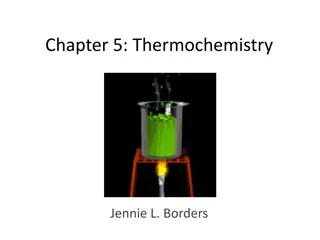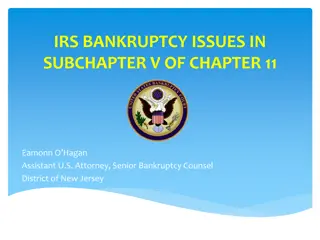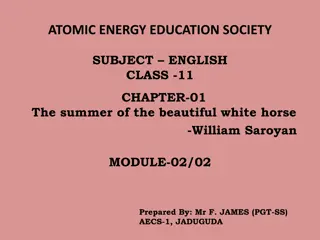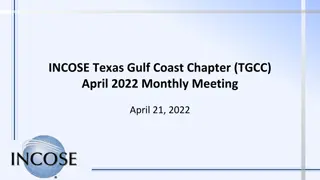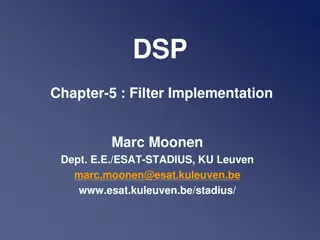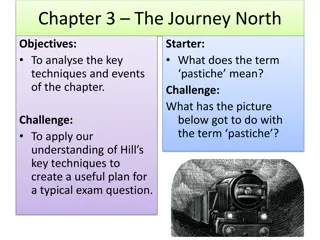
Innovative Practices Beyond Intellectual Property
Explore alternatives to traditional intellectual property rights, such as informal methods, open knowledge sharing, and prizes. Learn how innovators can strategically choose between formal and informal appropriation methods to secure returns on their innovations effectively. Delve into real-world examples like IBM's magnetic strip invention and the use of informal mechanisms in fostering innovation. Discover a holistic view of appropriation methods beyond conventional IP protection.
Download Presentation

Please find below an Image/Link to download the presentation.
The content on the website is provided AS IS for your information and personal use only. It may not be sold, licensed, or shared on other websites without obtaining consent from the author. If you encounter any issues during the download, it is possible that the publisher has removed the file from their server.
You are allowed to download the files provided on this website for personal or commercial use, subject to the condition that they are used lawfully. All files are the property of their respective owners.
The content on the website is provided AS IS for your information and personal use only. It may not be sold, licensed, or shared on other websites without obtaining consent from the author.
E N D
Presentation Transcript
Chapter 14 Alternatives to intellectual property Bronwyn H. Hall & Christian Helmers
Overview Alternatives to formal IP for ensuring innovation Informal methods (secrecy, lead time) Open sharing of knowledge Prizes and awards Use of formal and informal methods in practice Choice between formal and informal appropriation methods 2024 Hall & Helmers Ch. 14 2
Introduction Appropriation methods to secure returns: Informal/alternative : based on actions undertaken by innovator without recourse to legal protection (except possibly ex post). Formal: defined by the legal system, often requiring some kind of registration. In practice, choice between formal and informal mechanisms not so stark, innovators often combine different mechanisms - especially over time as different mechanisms may be more useful during different stages of the R&D and commercialization process. Understanding choice between different appropriation mechanisms important for design of the optimal incentives to innovate. 2024 Hall & Helmers Ch. 14 3
Introduction Informal mechanisms include secrecy, lead time, complexity, complementary sales or assets, etc. Allow firms to appropriate returns on their innovations but are fundamentally different from IP: Do not require any form of official registration or examination. Legal protection very limited; no legal protection that grants (temporary) exclusivity. Limited legal protection does not make alternative appropriation mechanisms necessarily weaker for appropriation. Effectiveness combined with lack of registration or examination requirements makes them popular among innovators (lower cost). 2024 Hall & Helmers Ch. 14 4
Introduction Open sharing in some environments, the benefits of learning from other innovators outweighs fear of imitation, especially in new technologies, leading to knowledge sharing rather than use of formal IP (not be confused with open innovation, which may involve the use of IP licensing). Prizes and awards useful for eliciting innovation for well-defined needs. 2024 Hall & Helmers Ch. 14 5
Magnetic strip In 1960, IBM engineer Forrest Parry invented magnetic strip. IBM never patented magnetic strip. For every buck we spent on developing the mag stripe, we got $1500 back in computer sales [...]. Our motive was to drive computer sales, and we did. Appropriation occurred via the sale of a complementary proprietary technology: computers, IBM s main line of business at the time. 2024 Hall & Helmers Ch. 14 6
WD-40 Multi-use product launched in 1958 that protects metal from rust and corrosion, penetrates stuck parts, displaces moisture and lubricates almost anything . Although clearly patentable, WD-40 company opted for secrecy. Lack of patent allowed competitors to bring very similar products to market, but avoided disclosure of the chemical formula until today. Patent would have expired probably some time in the late 1970s, and competitors would have been able to produce an exact copy then. 2024 Hall & Helmers Ch. 14 7
Secrecy Secrecy most widely used form of protection: regardless of whether product or process invention, but secrecy more important in complex than discrete technologies. Secrecy considered by far most effective way of appropriating returns to innovation. Secrecy can be used to protect things that are not otherwise protectable, such as customer lists. 2024 Hall & Helmers Ch. 14 8
Trade Secrecy In practice, trade secrecy bolstered by private contracts with employees and business partners such as non-disclosure, confidentiality, or non-compete agreements. Not a property right since its holder does not acquire exclusive right to the secret. If secret leaks or another company discovers same invention independently by legal means, holder of trade secret has no legal recourse. No registration requirement. No term limit. 2024 Hall & Helmers Ch. 14 9
Trade Secrecy 2 conditions for legal trade secrecy protection: 1. Information has independent commercial value because it is not readily available to others. 2. Holder of secret has to take reasonable precautions to prevent its disclosure. Condition 1 relatively weak, should expect that competitors are only interested in information that translates into some commercial advantage. Condition 2 imposes a duty on owner of information to take active reasonable measures to prevent inadvertent disclosure. U.S. Uniform Trade Secrets ACT (UTSA) defines reasonable efforts as: Advising employees of the existence of a trade secret. Limiting access to the secret on a need to know basis. Controlling plant access (i.e. physical location where secret is held). 2024 Hall & Helmers Ch. 14 10
Leakage Example: Confidential documents inadvertently made publicly available on a court's online cloud storage folder during the discovery stage of court case Epic Games vs. Apple. Secrets related to a vast range of internal business information involving litigants, Epic Games and Apple, but also related to business dealings with third parties, such as Netflix and Microsoft. Documents quickly removed from cloud storage, but information had already widely spread and was soon publicized by various news outlets. Another example: Simple mishap led to public revelation of Apple's iPhone 4 ahead of its official announcement date in 2010. An Apple engineer accidentally left the prototype in a bar. 2024 Hall & Helmers Ch. 14 11
Misappropriation Example: former Apple hardware engineer downloaded several Apple internal files that contained information on Apple's driverless technology shortly before giving notice and moving to China to take up employment with Guangzhou based start-up Xiaopeng Motors, which worked on similar technology. Trade secrecy misappropriation can be a crime. In U.S., under the Economic Espionage Act, theft of a trade secret used in interstate or foreign commerce can result in imprisonment, as it did in the case of the former Apple engineer. 2024 Hall & Helmers Ch. 14 12
Misappropriation Anthony Levandowski moved from Google's Waymo to Uber in 2016. Subsequent litigation between the two firms as well as Levandowski over trade secret theft. Uber paid Waymo $245 million in 2018. Levandowski sentenced to 18 months in jail and owed Waymo $179 million (in 2022 Uber agreed to pay Waymo something less than this amount to settle his case). In practice, employees one of the main vehicles for trade secrecy misappropriation. 2024 Hall & Helmers Ch. 14 13
Misappropriation Is trade secrecy good for innovation? Increases incentives to innovate if there is legal recourse against misappropriation. May incentivize investing resources in theft as means to acquiring information. May reduce innovation or increase prices because it restricts information available to competitors, which facilitates competition and could lower prices. Law penalizes only theft but not reverse engineering, so it incentivizes investment in reverse engineering rather than theft. Makes sense since might be difficult to prove reverse engineering in practice and reverse engineering can lead to learning and incremental innovation. Economic argument for the legal protection of trade secrets is simple: protection against theft of new ideas encourages investment in R&D and discourages investment in misappropriation (imitation). 2024 Hall & Helmers Ch. 14 14
The economics of trade secrets [T]he law of trade secrets is a neglected orphan in economic analysis. (Friedman et al., 1991: 61) Main economic argument for the legal protection of trade secrets is to encourage investment in R&D. Additional arguments: Allows firms to disclose inventions under some conditions, thereby enable trade and collaboration between firms. Avoids over-investment in keeping secrets secret. 2024 Hall & Helmers Ch. 14 15
The economics of trade secrets Downsides to the use of secrecy to appropriate returns to innovation: Increased potential for duplication of R&D. Reduce knowledge spillovers, if spillovers and own R&D are substitutes, this leads to less R&D. Non-competes: Reduce employee incentives by restricting ability to move (and thereby appropriate returns). Increase firm's ability to appropriate returns to high-risk, high-return R&D through employee retention. May slow innovation, especially in the early phases of an industry (Saxenian 1996, Gilson 1999). 2024 Hall & Helmers Ch. 14 16
Lead time and first-mover advantage Lead time more popular than secrecy to protect product innovations, also more important for smaller firms. Lead time: Time a firm takes to bring an innovation from its inception to market (Clark et al. 1987). How much faster a company can bring a new product or service to market than its competitors. Being first with a new process or product (Levin et al. 1997). Lead time closely related to another informal mechanism, first-mover advantage. First-mover advantage: edge a firm gains from introducing an innovation first to a new industry or product category. 2024 Hall & Helmers Ch. 14 17
Lead time and first-mover advantage Lead time and first-mover advantage often come from some technological advantage which translates into being first thanks to specific capabilities, foresight, or just luck (Lieberman and Montgomery, 1988). Benefits: More time to build expertise, prevent access by competitors to scarce resources. Temporary exclusivity simply by being the only one on the market. Temporary exclusivity can translate into lasting market power by creating customer loyalty, especially if there are network effects. 2024 Hall & Helmers Ch. 14 18
Lead time and first-mover advantage Effectiveness of lead time varies depending on the pace at which technology is evolving and the market expanding (Suarez and Lanzolla, 2005). William Henry Hoover's vacuum cleaner launched in 1908. Hoover the first to sell upright bag-on stick vacuum cleaner. Uptake was relatively slow and so was the technological development. Combination of slowly expanding demand and slow technological progress meant that Hoover was able to cement his first mover advantage to the extent that his name became synonymous with an entire product category. 2024 Hall & Helmers Ch. 14 19
Lead time and first-mover advantage Effectiveness of lead time varies depending on the pace at which technology is evolving and the market expanding (Suarez and Lanzolla, 2005). Netscape released web browser Mosaic Netscape 9.0 in 1994 (later renamed into Netscape Navigator). Dominated emerging/fast-growing browser market in mid-1990s. Netscape quickly lost dominant position to Microsoft and Netscape browser was discontinued. First-mover advantage did not result in lasting competitive advantage as market expanded and technology evolved extremely fast (and Microsoft (ab)used its market power in operating systems to promote own browser). 2024 Hall & Helmers Ch. 14 20
The use of formal and informal mechanisms Problem of observability when studying secrecy and other informal mechanisms. Ask firms about: Effectiveness/importance of formal & informal IP. Use of formal & informal IP. Loose link with economic theory. Main results (U.S., Europe, Canada): Patents not the most important mechanism Secrecy and lead time much more effective/used Holds regardless of product/process innovation Patents require too much disclosure of information while at the same time being relatively easy to invent around Secrecy is more important to smaller firms Important differences between discrete & complex industries Results sensitive to who is asked. 2024 Hall & Helmers Ch. 14 21
Importance of different IP mechanisms to U.S. firms in 2008 (%) 2024 Hall & Helmers Ch. 14 22
Yale survey results by appropriation method (1983) 2024 Hall & Helmers Ch. 14 23
Yale survey results: effectiveness of patents by industry (1983) 2024 Hall & Helmers Ch. 14 24
Carnegie-Mellon survey results (1994) 2024 Hall & Helmers Ch. 14 25
Share of innovating firms rating different types of IP protection as medium or highly important 2024 Hall & Helmers Ch. 14 26
The Choice between formal and informal mechanisms: patenting vs. secrecy Why do firms choose informal or formal intellectual property protection? Focus on the choice between patenting and secrecy. Good starting point because in principle secrecy and patenting are mutually exclusive. Factors that influence innovator's choice between patenting and secrecy also apply to other formal and informal appropriation mechanisms. 2024 Hall & Helmers Ch. 14 27
Patent only vs. Secrecy only 2024 Hall & Helmers Ch. 14 28
Patent only vs. Secrecy only Factors considered by theory: Disclosure Competition for innovation - simultaneous discovery Lead time and complexity Cumulative or sequential innovation 2024 Hall & Helmers Ch. 14 29
Disclosure (Anton and Yao, 2004) Model that analyzes role of information disclosure required by a patent on a firm s choice between patenting and secrecy. Disclosure has two effects: 1. Provides information that competitors can use to innovate. 2. Can signal a competitive edge to competitors. Generates a trade-off between the exclusionary effect of a patent and the disclosure required by a patent, which promotes competition. Anton and Yao s main (and somewhat counterintuitive) result is that large inventions are kept secret and only small inventions are patented. 2024 Hall & Helmers Ch. 14 30
Patent only vs. Secrecy only Anton and Yao model only looks at the interaction between a single innovator and a potential imitator. In practice, often more than one innovator that compete to innovate first. Results in race to innovate before others do. Innovators have to factor in that if they fail to patent first, a competitor will and effectively exclude them from the market. Patenting assumes a more defensive role. This can overturn the disclosure results by Anton and Yao because patenting dominates secrecy even in situations where secrecy offers stronger protection (Kultti et al., 2006). 2024 Hall & Helmers Ch. 14 31
Patent-secrecy combination Different aspects of an invention can be protected by patents or secrecy Combination of both mechanisms can be better than choosing one or the other. Example: in pharmaceuticals, chemicals are easily codifiable and protected by patents. Also contain tacit elements, such as the specific combination of different ingredients, which may be more effectively protected by secrecy. Firms may also use the patent system in ways (e.g. continuations) that allows them to de facto combine patenting with secrecy. 2024 Hall & Helmers Ch. 14 32
No patent, no secrecy: disclosure and publishing Open innovation business model: Innovators eschew patent protection while disclosing and making innovations available to third parties. Strategic tool: defensive publications (IBM s Technical Disclosure Bulletin, Google s Technical Disclosure Commons): Ensure freedom to operate by preventing others from patenting the same or similar inventions and thereby blocking the innovator. Influence the state of the art and obstruct a competitor s patent strategy. Signal a lead to competitors in a specific technology. 2024 Hall & Helmers Ch. 14 33
Innovation without IP Substantial innovation among communities that share information rather than keeping it secret or protecting it with IP rights. Characteristic of very early phases of a new technology and the industry it creates. Also common in scientific research community. 2024 Hall & Helmers Ch. 14 34
Open science What motivates scientists? Puzzles and priority (Stephan, 2012) Priority system accompanied by (uncertain) rewards ensures early publication of scientific results that everyone can access in principle. Open science system enables basic and sometimes applied scientific research to progress because it makes spillovers from such research almost costless to access and ensures that they are spread as wide as possible. Openness leads to the exploration of more diverse research paths because it enables a wider range of researchers to build on discoveries (Murray et al. 2008). 2024 Hall & Helmers Ch. 14 35
Open science 5 properties of open science system (Merton, 1973): Communism: there is common ownership of scientific discoveries; scientists give up their IP in exchange for recognition and esteem. Universalism: claims to truth are evaluated in terms of universal or impersonal criteria, and not on the basis of race, class, gender, religion, or nationality. Disinterestedness: scientists are rewarded for acting in ways that outwardly appear to be selfless. Originality: novelty in research contributions. Skepticism: all ideas should be subject to rigorous, structured community scrutiny. Breakdown in the system at the edges, in form of scientists starting firms to exploit their discoveries, or operation of university technology transfer offices (TTOs). 2024 Hall & Helmers Ch. 14 36
Collective invention Collective invention: setting where a number of firms and inventors develop a technology in a specific area who choose not to protect their inventions but instead to share them with each other. Often at very early stages of a new technology or industry where no single design or paradigm dominates. 3 features of collective invention (Allen, 1983): 1. Overall rate of change is dominated by incremental innovations. 2. Firms make technical information about performance and operation of their inventions public. 3. Firms employ the common pool of knowledge thus generated to make further improvements. 2024 Hall & Helmers Ch. 14 37
Proprietary versus Public Domain Regimes As time passes innovation in free knowledge sharing settings becomes privatized via IP. Exception is basic scientific research supported by a set of institutions (universities, government laboratories, non-profit research organizations). Model of choice by a researcher to participate in public domain (PD) or proprietary (PR) research (Gambardella and Hall, 2006). Equilibrium exists where some researchers work in the public domain and some privatize their research. But equilibrium not robust to changes in profit environment. PD must be sustained by norms or other means. 2024 Hall & Helmers Ch. 14 38
Proprietary versus Public Domain Regimes N researchers with utility function U that is a function of their choice of PD versus PR and the number of researchers working in PD. Utility of n-th researcher is: ? = ? + ??(? 1) X(n-1) is stock of knowledge generated in PD by previous n-1 researchers. ? 0 measures extent to which utility depends on the previous knowledge stock. z is utility from own research: If researcher works in PD, ? = ?(?), i.e. contribution to the knowledge stock. If researcher works in PR, z = ?, i.e. profits from the knowledge. Researchers with ?(?) ? work in PD. 2024 Hall & Helmers Ch. 14 39
Proprietary versus Public Domain Regimes Researchers are heterogeneous, ? ?(?) has distribution ? .|? . A stable equilibrium is achieved when the following holds: ? 0 ??= ??/? ?? is the share of researchers working under PD. In equilibrium this share is equal to the share of researchers whose utility from ? is not larger than the utility of their contribution ?(??) to PD knowledge. The equilibrium is stable if the slope of the distribution function F at that point is less than 1/N. 2024 Hall & Helmers Ch. 14 40
Proprietary versus Public Domain Regimes 2024 Hall & Helmers Ch. 14 41
Proprietary versus Public Domain Regimes It is possible that a group of researchers able to coordinate would choose to join PD because it was jointly profitable, even if at least one of them had profits greater than the benefits they receive from PD research in which they participate. But equilibrium unstable unless there is some form of coordination, as the researcher with large potential profits has an incentive to defect. In open science, coordination has generally been achieved via a number of social norms. Social norms in industry weaker, benefits of reciprocal knowledge sharing also lower after. Example of industry norm in open source software: General Public License (GPL). 2024 Hall & Helmers Ch. 14 42
Prizes and awards Prizes and awards are another, non-IP incentive mechanism distinct from informal appropriation mechanisms and the open sharing paradigm. Simple idea: innovators are compensated directly through monetary awards in form of prizes. If prize-winning innovation enters the public domain, prizes have advantage that there is no dead-weight loss due to exclusivity as opposed to patent protection. But for this to work need to assume that innovators and prize sponsors have full information over the value of the invention before innovators successfully produce the innovation. In practice, innovators have some private information regarding value of an invention. Challenges the efficiency of prizes as an incentive mechanism. 2024 Hall & Helmers Ch. 14 43
Prizes and awards Lots of historical examples: In 1773, Antoine Parmentier won the Acad mie de Besancon Prize for Substitute Foods for proposing the use of the potato as a food source. Of course, Quechua and Aymara in the Andes had been using potatoes this way for centuries. Orteig Prize awarded to Charles Lindbergh in 1927 for accomplishing the first non-stop flight from New York to Paris. The prize purse was US$ 25,000 (around US$ 420,000 in 2023) and helped spur intense competition among aviators to accomplish the goal set by the prize challenge. Various prizes for the discovery of a method to determine longitude at sea: Spanish Longitude Prize of 1567, Dutch Longitude Prize of 1627, and British Longitude Prize of 1714. 2024 Hall & Helmers Ch. 14 44
Prizes and awards Lots of modern examples: Fredkin Prize established in 1980 by academic computer scientist Edward Fredkin (reward US$ 100,000) - won in 1996 by IBM's Deep Blue creators for building the first computer chess program to beat the reigning chess world champion Gary Kasparov. Netflix prize for the best improvement of Netflix s algorithm that provides recommendations to Netflix subscribers (reward US$ 1 million). XPRIZE Foundation, a non-profit founded in 1994, regularly creates prize competitions to encourage specific innovations across technology fields - First XPRIZE competition was the Ansari XPRIZE in 1996, which awarded US$ 10 million to the first reusable spacecraft that would fly 100km into space within two weeks. Online platforms, such as Wazoku s innocentive or topcoder where anyone can make prize challenges available to anyone interested. 2024 Hall & Helmers Ch. 14 45
Prizes and awards Prizes have also been used by governments to procure innovation. DARPA has launched series of prize competitions since 2004, such as the subterranean challenge in2017 which seeks novel approaches to rapidly map, navigate, and search underground environments during time- sensitive combat operations or disaster response scenarios. Collaborations between public and private entities, such as the Lunar Lander Challenge jointly organized by NASA, private aerospace company Northrop Grumman, and the XPRIZE Foundation. Obama s Strategy for American Innovation explicitly encouraged the use pf prizes to incentivize innovation. America Competes Reauthorization Act of 2011 allowed federal agencies to offer innovation prizes. 2024 Hall & Helmers Ch. 14 46
Prizes and awards Prizes are seen as a possible mechanism to address big social challenges, so called grand missions , such as climate change or global public health. Grand missions are not likely to be completely funded by the market, given the diffuse nature of the potential benefits and the fact that these problems have substantial externalities. Non-market based mechanisms seen as more promising than market- based mechanisms such as patents (Murray et al. 2012). 2024 Hall & Helmers Ch. 14 47
Prizes and awards Ex ante prizes (inducement prizes): Incentive for specific innovation (targeted prize) Objective and criteria/performance standards defined ex ante Solution to sponsor's problem/needs Ex post prizes (awards): Broader objective and criteria potentially less well defined ex ante Submission and selection occurs after innovation Patent buy-out. Ex post prizes tend to reward and hence encourage blue-sky research while ex ante prizes are more likely to generate solutions to specific, well-defined problems, often of direct interest to the prize sponsor. Prizes and awards with/out monetary award. Allow patenting of prize-winning innovation or not. 2024 Hall & Helmers Ch. 14 48
Prizes and awards Drawbacks: How to determine optimal value of prize/award Duplication of research efforts Winner takes all Avoid blue sky research Produces inventions not innovation Awards: selection by jury/committee Advantages: Direct research efforts in specific direction Induces competition among innovators Investment multiplier effects Publicity effect 2024 Hall & Helmers Ch. 14 49
Prizes and awards Evidence on prizes awarded by Royal Agricultural Society of England from 1839 to 1939 (Brunt et al. 2012): Both ex ante and ex post prizes. Ex ante prizes were monetary awards while ex post prizes were in form of medals. Award had a positive impact on subsequent patent filings on award-winning inventions. Effect stronger for medals than monetary prizes. Evidence on ex post prizes (without monetary award) awarded for innovations exhibited at Crystal Palace Exhibition in 1851 (Moser and Nichols, 2013): Increase in patenting for prize-winning innovations compared to non-winning innovations. Evidence for award effect due to publicity. 2024 Hall & Helmers Ch. 14 50





